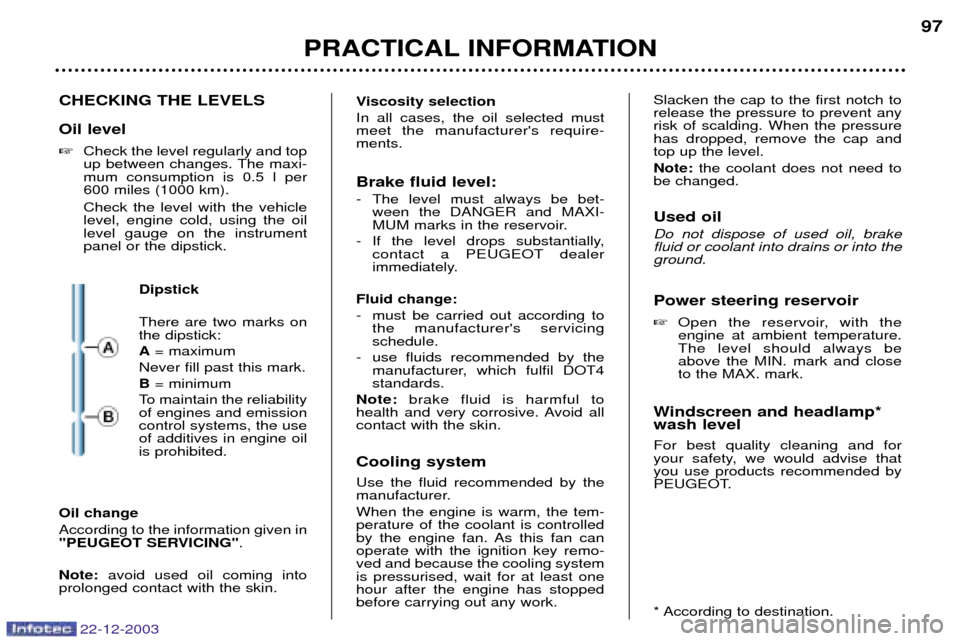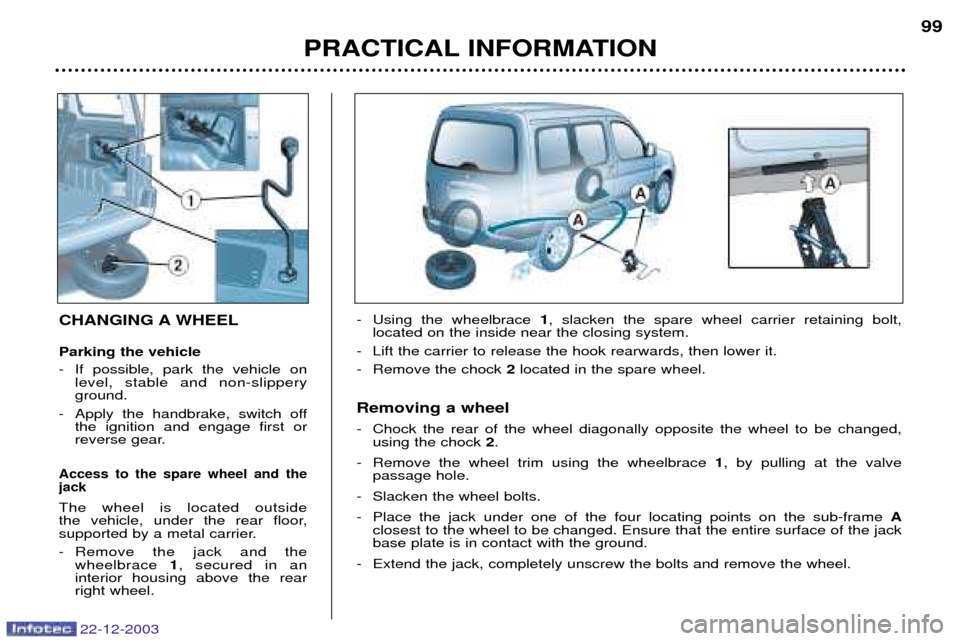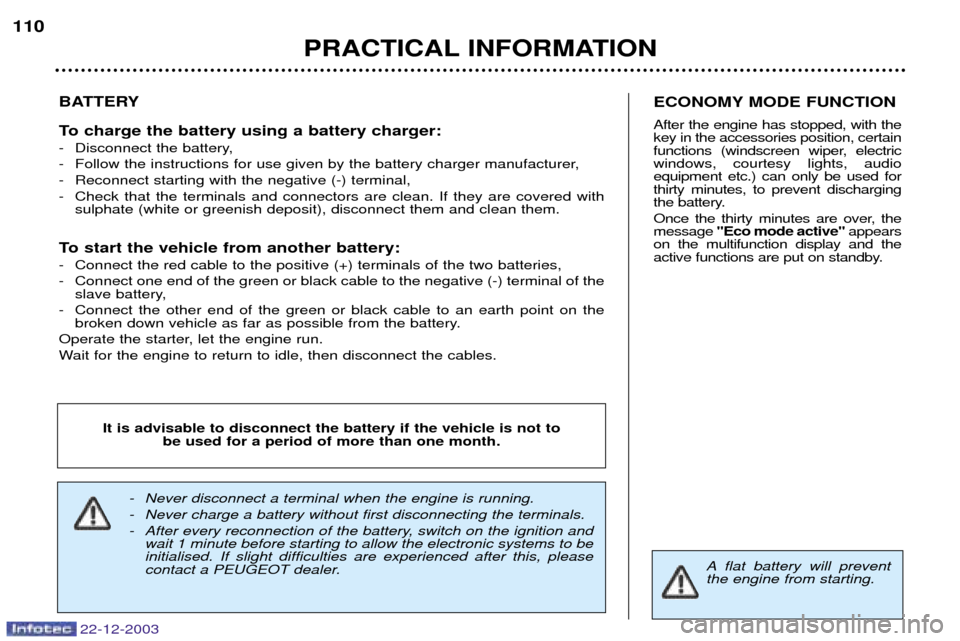Page 94 of 128

22-12-2003
Disarming the passenger air bag*
To ensure the safety of your child, it is essential to disarm the pas-senger air bag when you install arear-facing child seat on the frontpassenger seat. Otherwise, thechild would risk being killed orseriously injured if the air bagwere to inflate. �With the ignition switched off ,
insert the key into the passenger air bag disarming switch 1, turn it
to the "OFF" position, then remo-
ve the key keeping the slot in thisposition.
The air bag warning lighton the instrument panel islit throughout the disarmingprocess.
* According to destination.
YOUR PARTNER IN DETAIL
90
FRONT AIR BAGS These are folded in the centre of the steering wheel for the driver and in
the fascia for the front passenger.
They are deployed simultaneously,except in cases where the passengerair bag is disarmed. Front air bag fault
If this warning light comes onon the instrument panel, accompanied by an audiblesignal, contact a PEUGEOT
dealer to have the systemchecked.
AIR BAGS The air bags have been designed to maximise the safety of the occupants in the event of serious
collisions. They work in conjunctionwith the pretensioning seat belts. The electronic detectors register and analyse any abrupt decelerationof the vehicle: if the triggering threshold is reached, the air bagsinflate instantly and protect theoccupants of the vehicle. Immediately after the impact, the air bags deflate rapidly so that they donot hinder the visibility of the occupants nor their exit if necessaryfrom the vehicle. The air bags are not deployed in the case of minor collisions, for which
the seat belt is sufficient to ensure
maximum protection. The serious-ness of a collision depends on thenature of the obstacle and the speedof the vehicle at the moment ofimpact. Air bags only operate when the ignition is switched on. Note:
the gas escaping from the air
bags can be a minor irritant.
Page 95 of 128
22-12-2003
YOUR PARTNER IN DETAIL91
In the
"OFF" position, the passen-
ger air bag will not be triggered in the event of an impact. As soon as the child seat is remo- ved, turn the air bag slot to the "ON"
position to re-activate the air bagand thus ensure the safety of yourpassenger in the event of an impact. Operating check
With the ignition on (2nd notch), illumination of thiswarning light indicates thatthe passenger air bag isdisarmed (switch in the"OFF"position).SIDE AIR BAGS* These are incorporated into the frame of the front seat backs, on thedoor side. They are deployed independently of each other depending on which sidethe collision occurs, in collisionswhich could cause injury to thechest, the abdomen or the head. Air bag fault
If this warning light comes on, accompanied by anaudible signal, contact a
PEUGEOT dealer to havethe system checked.
* According to destination.
Page 97 of 128
22-12-2003
YOUR PARTNER IN DETAIL91
In the
"OFF" position, the passen-
ger air bag will not be triggered in the event of an impact. As soon as the child seat is remo- ved, turn the air bag slot to the "ON"
position to re-activate the air bagand thus ensure the safety of yourpassenger in the event of an impact. Operating check
With the ignition on (2nd notch), illumination of thiswarning light indicates thatthe passenger air bag isdisarmed (switch in the"OFF"position).SIDE AIR BAGS* These are incorporated into the frame of the front seat backs, on thedoor side. They are deployed independently of each other depending on which sidethe collision occurs, in collisionswhich could cause injury to thechest, the abdomen or the head. Air bag fault
If this warning light comes on, accompanied by anaudible signal, contact a
PEUGEOT dealer to havethe system checked.
* According to destination.
Page 103 of 128

22-12-2003
CHECKING THE LEVELS Oil level �Check the level regularly and top
up between changes. The maxi-mum consumption is 0.5 l per600 miles (1000 km). Check the level with the vehicle level, engine cold, using the oillevel gauge on the instrumentpanel or the dipstick.
Dipstick There are two marks on the dipstick: A= maximum
Never fill past this mark. B = minimum
To maintain the reliability of engines and emissioncontrol systems, the useof additives in engine oilis prohibited.
PRACTICAL INFORMATION 97
Viscosity selection In all cases, the oil selected must meet the manufacturer's require-ments. Brake fluid level:
- The level must always be bet-
ween the DANGER and MAXI-
MUM marks in the reservoir.
- If the level drops substantially, contact a PEUGEOT dealer
immediately.
Fluid change:
- must be carried out according to the manufacturer's servicing schedule.
- use fluids recommended by the manufacturer, which fulfil DOT4standards.
Note: brake fluid is harmful to
health and very corrosive. Avoid allcontact with the skin. Cooling system Use the fluid recommended by the
manufacturer. When the engine is warm, the tem- perature of the coolant is controlled
by the engine fan. As this fan canoperate with the ignition key remo-ved and because the cooling systemis pressurised, wait for at least onehour after the engine has stoppedbefore carrying out any work. Slacken the cap to the first notch torelease the pressure to prevent anyrisk of scalding. When the pressurehas dropped, remove the cap andtop up the level. Note:
the coolant does not need to
be changed. Used oil Do not dispose of used oil, brake fluid or coolant into drains or into theground. Power steering reservoir � Open the reservoir, with the engine at ambient temperature.The level should always beabove the MIN. mark and closeto the MAX. mark.
Windscreen and headlamp*wash level For best quality cleaning and for
your safety, we would advise thatyou use products recommended by
PEUGEOT.
* According to destination.
Oil change According to the information given in
"PEUGEOT SERVICING" .
Note: avoid used oil coming into
prolonged contact with the skin.
Page 105 of 128

22-12-2003
PRACTICAL INFORMATION99
CHANGING A WHEEL Parking the vehicle
- If possible, park the vehicle on
level, stable and non-slippery ground.
- Apply the handbrake, switch off the ignition and engage first or
reverse gear.
Access to the spare wheel and thejack
The wheel is located outside
the vehicle, under the rear floor,
supported by a metal carrier.
- Remove the jack and the wheelbrace 1, secured in an
interior housing above the rear right wheel. - Using the wheelbrace
1, slacken the spare wheel carrier retaining bolt,
located on the inside near the closing system.
- Lift the carrier to release the hook rearwards, then lower it.
- Remove the chock 2located in the spare wheel.
Removing a wheel
- Chock the rear of the wheel diagonally opposite the wheel to be changed, using the chock 2.
- Remove the wheel trim using the wheelbrace 1, by pulling at the valve
passage hole.
- Slacken the wheel bolts.
- Place the jack under one of the four locating points on the sub-frame A
closest to the wheel to be changed. Ensure that the entire surface of the jack base plate is in contact with the ground.
- Extend the jack, completely unscrew the bolts and remove the wheel.
Page 117 of 128

PRACTICAL INFORMATION
110
22-12-2003
BATTERY
To charge the battery using a battery charger:
- Disconnect the battery,
- Follow the instructions for use given by the battery charger manufacturer,
- Reconnect starting with the negative (-) terminal,
- Check that the terminals and connectors are clean. If they are covered with
sulphate (white or greenish deposit), disconnect them and clean them.
To start the vehicle from another battery:
- Connect the red cable to the positive (+) terminals of the two batteries,
- Connect one end of the green or black cable to the negative (-) terminal of the slave battery,
- Connect the other end of the green or black cable to an earth point on the broken down vehicle as far as possible from the battery.
Operate the starter, let the engine run.
Wait for the engine to return to idle, then disconnect the cables.
- Never disconnect a terminal when the engine is running.
- Never charge a battery without first disconnecting the terminals.
- After every reconnection of the battery, switch on the ignition and wait 1 minute before starting to allow the electronic systems to be initialised. If slight difficulties are experienced after this, please
contact a PEUGEOT dealer. A flat battery will preventthe engine from starting.
It is advisable to disconnect the battery if the vehicle is not to
be used for a period of more than one month.
ECONOMY MODE FUNCTION After the engine has stopped, with the key in the accessories position, certain
functions (windscreen wiper, electricwindows, courtesy lights, audio equipment etc.) can only be used forthirty minutes, to prevent discharging
the battery.
Once the thirty minutes are over, the message "Eco mode active" appears
on the multifunction display and the
active functions are put on standby.